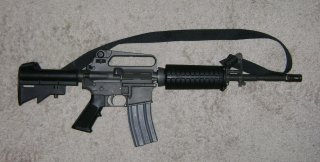This Is Why The U.S. Army Decided Colt's Rifles Weren't Good Enough
FN is eating Colt's lunch.
Key Point: If the “new” Colt wants to thrive, they need to find a way to innovate and develop new products.
Belgium’s Fabrique Nationale (FN) and Colt have long been competitors on the American firearms market. For almost a century both companies have competed for military contracts, designers, and sales on the American civilian market. However, in the 2000s, FN dealt a blow that stung Colt: it won a contract to produce the M16 rifle and M4 carbine, designs that were almost inextricably linked to the Colt brand. The story of how FN regained a foothold in the American market in the 1980s and continues to remain a couple steps ahead of Colt to this day is one of clever corporate maneuvering and complacency on Colt’s part. Unfortunately for Colt, following its bankruptcy in 2015, it has not come close to even competing with FN globally.
The beginning of Colt’s downfall in the modern era began around the 1980s. FN began making inroads into the US military market again around that time, as a version of their gas-operated FN MAG was adopted as a vehicle coaxial machine gun in 1977, followed by the adoption of the FN Minimi as the M249 in 1984. FN had to build manufacturing facilities in the US to produce these guns, so they started competing for contract Colt had, notably the M16 rifle.
In 1988, FN beat out Colt on a tender to produce M16A2 rifles, undercutting Colt’s bid by $57.50 per rifle. Colt’s patents on the rifle had expired in 1983. However, Colt had one last card to play. Around that time, Colt was finishing up development of the XM4 Carbine, building on a long lineage of shortened AR carbines produced since the Vietnam War. The XM4 was adopted as the M4 in 1994, and would become Colt’s primary product throughout the global war on terror. However, Colt would not innovate significantly since then, and in 2013 FN grabbed Colt’s M4 contract, which they already partially lost to Remington Defense before.
However, Colt continued to stagnate in innovation, with their only real successful product in the meantime being the short lived M45A1 CQBP which was adopted by the U.S. Marine Corps in 2012. Unlike Colt Canada, a spinoff of Colt that developed monolithic upper receivers that saw wide purchases with special forces worldwide, Colt in the 2000s and 2010s was happy to sit on their existing product line.
This lead to their eventual bankruptcy in 2015, followed by a restructuring. The resurrected company has seen limited success, splitting another M4 contract with FN in 2018. But it still appears to be relatively non-competitive compared to FN, as the latter has alternate product lines but Colt still just has the M4 and variants of it.
A possible reason for Colt’s stagnation was put forth by Chris Bartocci, a former Colt employee. Bartocci argues that when Colt brought in William M. Keys as the CEO of Colt, Keys proceeded to mostly appoint other former Marine Corps officers as managers in the company. This lead to people who were good officers but bad corporate managers being put into place in Colt, leading to an overall lack of corporate vision.
While that may only be one man’s perspective, from the outside it’s clear that FN has eaten Colt’s lunch over the last few decades in the American market. If the “new” Colt wants to thrive, they need to find a way to innovate and develop new products. Colt has been notably absent in the latest next-generation rifle trials, but they could potentially shack up with other American defense names if they present themselves as a worthy partner.
Charlie Gao studied political and computer science at Grinnell College and is a frequent commentator on defense and national security issues. This piece was originally featured in August 2019 and is being republished due to reader's interest.
Image: Creative Commons.

